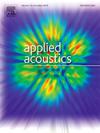超材料夹层板的低频拓扑边角态
IF 3.4
2区 物理与天体物理
Q1 ACOUSTICS
引用次数: 0
摘要
近年来,拓扑边缘态和角态以其前所未有的波浪操纵能力引起了人们的广泛关注。然而,弹性拓扑波操作的大多数现有进展都是在超材料单层板上实现的,工作频率高,这限制了它们的实际适用性。为了实现低频拓扑边缘和角态,本文提出了一种具有压扭耦合芯的新型拓扑超材料夹层板。模拟量子谷霍尔效应(QVHE),通过不匹配c3v对称菱形单元胞中两个夹层芯的尺寸,实现了无间隙拓扑边缘态。为了实现高阶拓扑角态,将菱形单元胞加倍构造成c6v对称六边形单元胞。利用量子自旋霍尔效应(QSHE)实现了缺口边缘态,为拓扑角态的出现奠定了关键基础。对方格和菱形格的特征态分析表明,角态在钝角和锐角处都可以存在。观察到对称的拓扑角态和反对称的平凡角态,前者是缺陷免疫的。传输实验表明,振动可以被抑制在体积内,并定位在边缘和角落,验证了边缘和角落状态的存在。该研究将促进弹性拓扑超材料的发展及其在振动控制、能量收集、信号传感等方面的应用。本文章由计算机程序翻译,如有差异,请以英文原文为准。
Low-frequency topological edge and corner states in metamaterial sandwich plates
Recently, topological edge and corner states have attracted significant attention for their unprecedented wave manipulation capabilities. However, most existing advancements in elastic topological wave manipulation have been achieved in metamaterial monolayer plates, operating at high frequencies, which limits their practical applicability. To achieve low-frequency topological edge and corner states, this study presents an innovative topological metamaterial sandwich plate with compression-torsion coupling cores. Mimicking quantum valley Hall effect (QVHE), the gapless topological edge states are achieved by mismatching the sizes of two sandwich cores in C3v-symmetric rhombic unit cell. To realize higher-order topological corner states, the C6v-symmetric hexagonal unit cell is constructed by doubling rhombic unit cells. Leveraging quantum spin Hall effect (QSHE), gapped edge states are achieved, laying a critical foundation for the emergence of topological corner states. Eigenstate analysis of rhombic and square lattices presents that corner states can exist at both obtuse and acute angles. Symmetrical topological corner states and anti-symmetrical trivial corner states are observed, with the former being defect-immune. Transmission experiments demonstrate that vibration can be suppressed within the bulk and localized at the edges and corners, validating the presence of edge and corner states. This study could facilitate the development of elastic topological metamaterials and their application in vibration control, energy harvesting, signal sensing, etc.
求助全文
通过发布文献求助,成功后即可免费获取论文全文。
去求助
来源期刊

Applied Acoustics
物理-声学
CiteScore
7.40
自引率
11.80%
发文量
618
审稿时长
7.5 months
期刊介绍:
Since its launch in 1968, Applied Acoustics has been publishing high quality research papers providing state-of-the-art coverage of research findings for engineers and scientists involved in applications of acoustics in the widest sense.
Applied Acoustics looks not only at recent developments in the understanding of acoustics but also at ways of exploiting that understanding. The Journal aims to encourage the exchange of practical experience through publication and in so doing creates a fund of technological information that can be used for solving related problems. The presentation of information in graphical or tabular form is especially encouraged. If a report of a mathematical development is a necessary part of a paper it is important to ensure that it is there only as an integral part of a practical solution to a problem and is supported by data. Applied Acoustics encourages the exchange of practical experience in the following ways: • Complete Papers • Short Technical Notes • Review Articles; and thereby provides a wealth of technological information that can be used to solve related problems.
Manuscripts that address all fields of applications of acoustics ranging from medicine and NDT to the environment and buildings are welcome.
 求助内容:
求助内容: 应助结果提醒方式:
应助结果提醒方式:


